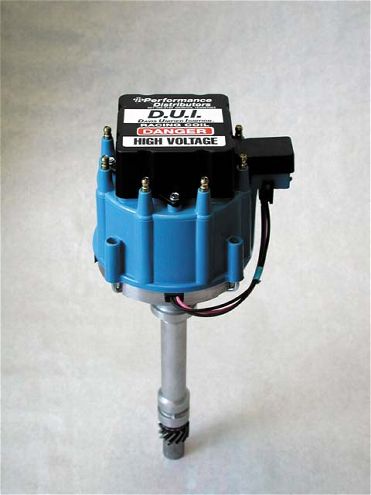
 If you are required by your sanctioning body's rules to run a OEM distributor, you likely are stuck with an High Energy Ignition (HEI) system, which can be a handicap. Performance Distributors has developed an HEI ignition that keeps the unit's strengths intact (self contained, simple) while eliminating its weaknesses.
If you are required by your sanctioning body's rules to run a OEM distributor, you likely are stuck with an High Energy Ignition (HEI) system, which can be a handicap. Performance Distributors has developed an HEI ignition that keeps the unit's strengths intact (self contained, simple) while eliminating its weaknesses.
Sometime around 1975, General Motors made a significant advancement in ignition technology: the High Energy Ignition (HEI to you and me). Its best feature was simplicity. The coil was contained within the distributor cap and it required the connection of only a single 12-volt wire. It was significantly better than the points distributor, the standard at the time, and the HEI went on just about everything GM produced until the mid-'80s when full-blown computers began running the engine controls.
The HEI has always caused headaches for racers. This ignition was designed specifically for low-revving street vehicles. Racers running a stock HEI ignition often develop a high engine-speed miss around 5,500 rpm that essentially acts as a rev limiter. The ignition simply cannot develop enough juice to properly fire the spark plugs beyond that speed.
Obviously, better and more dependable racing ignition systems have been developed since the HEI was first introduced in the mid-'70s. You won't find an HEI on a race car in the higher divisions, but many Street Stock and other entry-level racers are still required to run OEM ignitions. Since the greatest majority of the racing population races the Chevrolet 350, these racers are faced with competing with the HEI ignition that was included.
The good news is that there are options available for hopping up an HEI ignition. Most require the use of a remotely located spark box, which boots the amount of power the ignition sends to the plugs. Almost every company that manufactures ignition systems has a version of this setup. This is a good solution to an age-old problem, but more stringent racetracks may still not allow it. That is partially why Performance Distributors created its GM racing distributor with the internal coil and module completely contained within the rotor cap. There is even a completely black "stealth" unit available for the ultra-picky tech man.
The key drawback with stock HEI systems comes at higher rpm (usually beyond 5,500). In this range, there simply isn't enough dwell to properly charge the coil. Dwell is the amount of time the coil is allowed to recharge between firings. It is affected by the number of cylinders and the rpm. On an eight-cylinder engine, theoretically, dwell at 5,000 rpm is just 0.0015 second. If you are pushing 7,500 rpm on the racetrack, the coil has just 0.001 second between firings to recharge!
An HEI ignition is an inductive system, meaning the ignition coil is the sole source of energy storage until the energy is released to fire the spark plug. Ignition systems using a separate spark box or external coil are usually capacitive discharge systems. They use a storage capacitor to hold energy. The capacitor releases the energy to the coil, which raises the voltage and sends the energy on its way to the spark plug.
Advancing technology has allowed Performance Distributors to develop coil-winding techniques that significantly improve the coil's ability to store energy quickly. Also, its own high-performance module--the ignition's brain--is specially designed for high-rpm racing. Performance Distributors claims its D.U.I. GM racing distributors can put out a dependable spark hot enough to run an engine up to 9,000 rpm with the spark plugs gapped to 0.050 to 0.055 inch. (A bigger plug gap aids in-cylinder combustion.)
Another advantage of racing-specific HEI ignitions is the advance curve can be better tailored to fit the needs of a racing engine. Most street motors need the spark fully advanced fairly quickly in the rpm range. Because this has little effect on a race engine, racers have simply locked out the advance mechanism. Running an engine with no advance makes it difficult to start (especially once the engine is hot) and hurts low-rpm performance. Performance Distributors uses a mechanical advance assembly to eliminate premature wear and sloppiness that comes from stock advance mechanisms and will set up the advance curve on the ignition based on your engine.
If you need to upgrade, you will need to have the following engine information available: compression ratio, displacement, induction system (carburetor size and type), transmission (automatic or manual) a duration and lift of camshaft, octane rating of fuel, and normal racing rpm range, as well as the total weight of your race car.